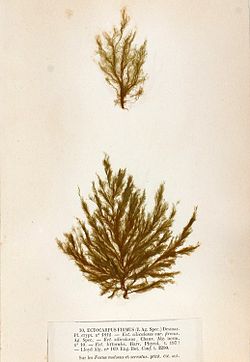| Pylaiella littoralis | |
|---|---|
 | |
| Scientific classification | |
| Domain: | Eukaryota |
| Clade: | Sar |
| Clade: | Stramenopiles |
| Phylum: | Ochrophyta |
| Class: | Phaeophyceae |
| Order: | Ectocarpales |
| Family: | Acinetosporaceae |
| Genus: | Pylaiella |
| Species: | P. littoralis |
| Binomial name | |
| Pylaiella littoralis (Linnaeus) Kjellman, 1872 | |
Pylaiella littoralis is a species of alga belonging to the family Acinetosporaceae. [1] It grows in an opposite branching pattern, with each branch growing to roughly 5 cm long.
Synonym: